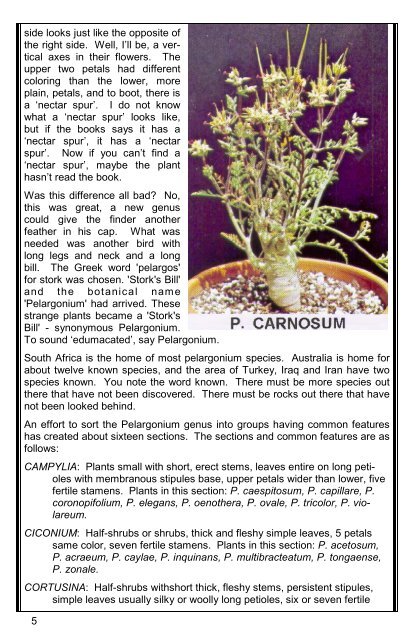ESPINAS Y FLORES - Library
ESPINAS Y FLORES - Library
ESPINAS Y FLORES - Library
Create successful ePaper yourself
Turn your PDF publications into a flip-book with our unique Google optimized e-Paper software.
side looks just like the opposite of<br />
the right side. Well, I’ll be, a vertical<br />
axes in their flowers. The<br />
upper two petals had different<br />
coloring than the lower, more<br />
plain, petals, and to boot, there is<br />
a ‘nectar spur’. I do not know<br />
what a ‘nectar spur’ looks like,<br />
but if the books says it has a<br />
‘nectar spur’, it has a ‘nectar<br />
spur’. Now if you can’t find a<br />
‘nectar spur’, maybe the plant<br />
hasn’t read the book.<br />
Was this difference all bad? No,<br />
this was great, a new genus<br />
could give the finder another<br />
feather in his cap. What was<br />
needed was another bird with<br />
long legs and neck and a long<br />
bill. The Greek word 'pelargos'<br />
for stork was chosen. 'Stork's Bill'<br />
and the botanical name<br />
'Pelargonium' had arrived. These<br />
strange plants became a 'Stork's<br />
Bill' - synonymous Pelargonium.<br />
To sound ‘edumacated’, say Pelargonium.<br />
South Africa is the home of most pelargonium species. Australia is home for<br />
about twelve known species, and the area of Turkey, Iraq and Iran have two<br />
species known. You note the word known. There must be more species out<br />
there that have not been discovered. There must be rocks out there that have<br />
not been looked behind.<br />
An effort to sort the Pelargonium genus into groups having common features<br />
has created about sixteen sections. The sections and common features are as<br />
follows:<br />
CAMPYLIA: Plants small with short, erect stems, leaves entire on long petioles<br />
with membranous stipules base, upper petals wider than lower, five<br />
fertile stamens. Plants in this section: P. caespitosum, P. capillare, P.<br />
coronopifolium, P. elegans, P. oenothera, P. ovale, P. tricolor, P. violareum.<br />
CICONIUM: Half-shrubs or shrubs, thick and fleshy simple leaves, 5 petals<br />
same color, seven fertile stamens. Plants in this section: P. acetosum,<br />
P. acraeum, P. caylae, P. inquinans, P. multibracteatum, P. tongaense,<br />
P. zonale.<br />
CORTUSINA: Half-shrubs withshort thick, fleshy stems, persistent stipules,<br />
simple leaves usually silky or woolly long petioles, six or seven fertile<br />
5


